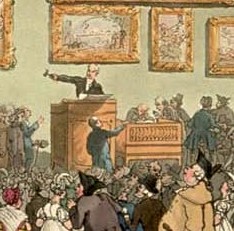Do Art Auction Houses Camouflage Results? – artmarketblog.com
 I received an email on December 2nd from one of Australia’s leading art auction houses, Menzies Art Brands, with the subject ‘Defamation Alleged’. The email read:
I received an email on December 2nd from one of Australia’s leading art auction houses, Menzies Art Brands, with the subject ‘Defamation Alleged’. The email read:
DEFAMATION ALLEGED
Menzies would like to bring to your attention this story on Page 10 of The Age newspaper today:
LEADING art auctioneer Rod Menzies has described as ”scurrilous” allegations made by Robert Le Tet and Rick Anderson about his business practices, in The Age yesterday.
Mr Menzies, an entrepreneur, cleaning business tycoon and owner of Menzies Art Brands, said he ”always honoured every deal” and was ”well known for carrying out every commitment and for his integrity”.
He said he observed the ”highest ethical standards” and denied suggestions to the contrary. He said in a statement that he had instructed his lawyers to start proceedings for defamation and damages claiming $38 million.
Enquiries
sydney@menziesartbrands.com
Before we continue, this is not the first time that allegations have been made regarding Menzies’ business practices. In 2008 complaints were made by other auction houses in Australia regarding Menzies’ alleged failure to adequately disclose details regarding guarantees provided by Menzies, as well as details regarding works being sold by Menzies that Menzies either owned or had a share in. Menzies denied the charges which were dropped in March of this year by the Australian Competition and Consumer Commission.
This time around, Menzies is being accused of misleading reporting of art sales through his auction house. The accusations were aired in the Melbourne, Australia based newspaper ‘The Age’ where details of a transaction involving a painting by Brett Whiteley, one of Australia’s most famous and valuable artists, were questioned. According to The Age, the painting in question was reported by Menzies Art Brands as having been sold in Sydney on the 25th of March for A$1.44 million. Apparently, however, only two months later Mr. Menzies was offering the painting in question for sale privately through his company for A$1.25 million, which suggests that it wasn’t sold at all. It is then alleged that Mr. Menzies struck a deal with a collector, named as a Mr. Anderson, to swap the Whiteley painting, and another painting, for two paintings owned by the collector. The swap apparently took place in June of this year.
If this allegation wasn’t enough, ‘The Age’ alleges further issues regarding ownership of the Whiteley painting. Apparently a Melbourne financier launched a court case to retrieve the Whiteley painting, which he claims he owns because his company, Questco Pty Ltd. , loaned money to an art dealer to purchase the Whiteley painting – a dealer who is now having financial difficulties. The Melbourne financier apparently then asked Menzies to sell the painting through private treaty for A$1.25 million, but Menzies reneged on the deal a short time later. Menzies is being accused of then returning the painting to the dealer, not the financier, and purchasing it off the dealer for A$850,000. Mr. Menzies then put the painting up for sale in March of this year, which is where this story began. Menzies sought to retrieve the painting from Mr. Anderson whom he sold the painting to by private treaty and apparently even offered several other paintings in exchange which had also been reported as having been sold at auction. Mr. Anderson has so far declined to return the painting.
According to the article in ‘The Age’:
Mr Anderson claimed Mr Menzies has been ”ramping” up the art auction market, and he said it was in the public interest to know how the prominent auctioneer operated: ”He reported the Whiteley painting as sold and then he offered it to me for $200,000 less than what it was supposedly sold for at auction,”.
No charges have been laid against Mr. Menzies or his company and, as you can see from the email I was sent, Mr. Menzies strongly denies the allegations made against him and his company. The question of who is telling the truth will presumably come to light if the defamation case goes ahead.
The reason that I have alerted you to this case is that I have been on a bit of an art auction house crusade of late in an attempt to inform the public about what goes on behind the scenes and hopefully encourage the art auction houses to be more transparent and ethical with their dealings. With transparency being one of the biggest issues, I thought it was important to highlight this case even though none of the allegations have been confirmed as being true. I will be doing a series on this issue as there are lots of allegations to cover.
 **Nicholas Forrest is an art market analyst, art critic and journalist based in Sydney, Australia. He is the founder of http://www.artmarketblog.com, writes the art column for the magazine Antiques and Collectibles for Pleasure and Profit and contributes to many other publications
**Nicholas Forrest is an art market analyst, art critic and journalist based in Sydney, Australia. He is the founder of http://www.artmarketblog.com, writes the art column for the magazine Antiques and Collectibles for Pleasure and Profit and contributes to many other publications
Filed under: art, art auction, art auction results, art auctions, art buyers, art collectors, art market, fine art | Tagged: art auction, art auctioneers, art investment, art market, artist, auction | 4 Comments »




































